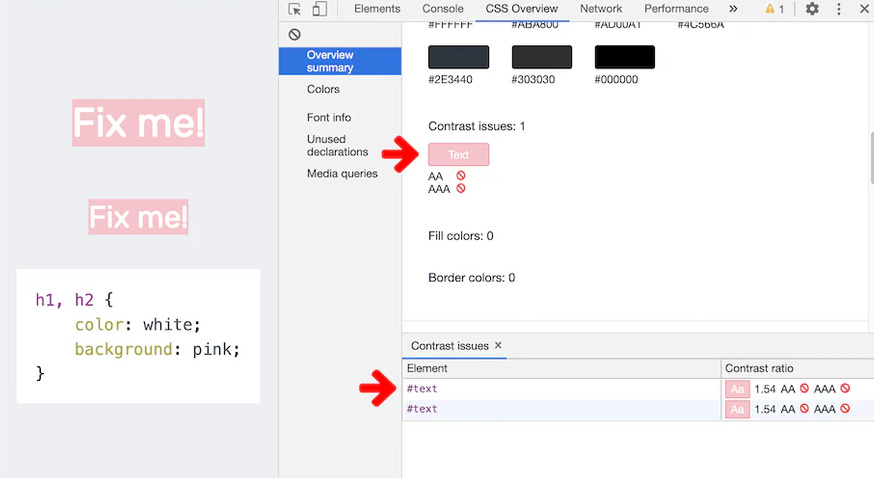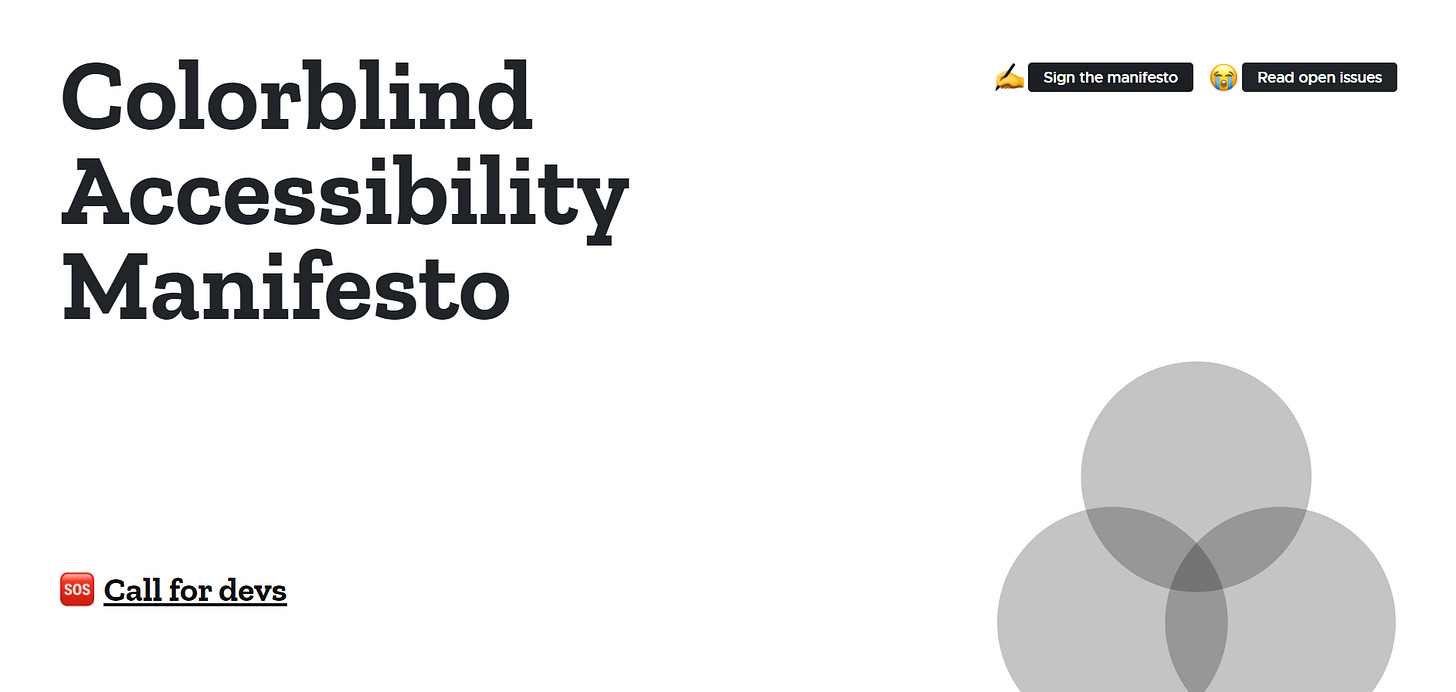Interview with Federico Monaco - UX designer and curator of 'Colorblind Accessibility Manifesto'
Born in 1998, Federico is the designer behind the 'Colorblind Manifesto', a project that aims to highlight a anything but a marginal problem like colorblind accessibility.
Federico is a 23-year-old designer, based in Turin, recently graduated in "Digital Communication Design" at IAAD, Institute of Applied Art to Design. His latest project of him went viral, so we had a pleasure chat and I had the chance to know him better.
In this interview we talked about his background, how he became a designer, his current and future projects.
A step back: what accessibility is?
Web accessibility is a comprehensive process that ensures that there are no barriers to interaction or access by people with disabilities on the web. In general, if a website is properly designed, developed and modified, all users will have equal access to information and functionality.
In Italy, web accessibility is regulated by the so-called 'Stanca Law', officially published in January 2004.
Although web accessibility aims to cover different types of topics and needs, in this specific case, we are talking about visual accessibility. In fact, color and contrast can be used to help users see and interpret web and app content, interact with the right components, and understand actions.
Color can help communicate mood, tone, and critical information. Primary, secondary and accent colors can be selected to support usability. Sufficient color contrast between elements can help visually impaired users see and use the digital products you design. So, make your design accessible means helping users of diverse abilities to navigate, understand, and use products and services like other people do.
That said, it’s time to talk about Federico.
Ciao Federico, can you tell us a little about you and your story?
Of course. My name is Federico Monaco, I am 23 years old and I live in Turin.
I approached the world of communication through the photographic studies I dealt with during high school. During that period I tried to understand if photography was the means of expression and communication that best suited me.
So I started to combine my studies with the current status of assistant photographer during weddings and sporting events. I understood that photography wasn’t enough, I felt a hunger for knowledge towards the world of communication.
Although the world of the User Experience was still unknown to me, in retrospect I realize how I had used that type of approach and mindset, that is to study, intuit and validate through a prototype, study again.
You have recently completed your studies at IAAD. What drives you to become a designer?
At the beginning of my academic career, I had no idea what a designer was. It is a word that we hear too often and of which we hardly try to give an interpretation or a real connotation.
Initially I thought that the designer was "the one who makes things beautiful". Through this three-year journey, especially during the realization of my thesis project, I understood who the designer really was: “the one who eliminates problems”.
What drives me to want to become a designer is precisely this desire to help, even if minimally, people to have as few points of friction as possible when they relate to digital objects during their daily lives.
Looking at your first experiences, the last with Bomberos, do you already have in mind the path you would like to take or are you exploring possible ways?
On the one hand, it would be nice to be able to continue to devote a large part to studying, facing a master of reference abroad, so as to be able to get in touch with a mentality and approach to design that is completely different from mine.
On the other hand, I find it equally stimulating to be able to undertake a work experience, in order to further validate my desire to work in the world of User Experience Design.
Right now I think I am more inclined to the second option, with the hope of finding a mentor to guide me.
The Colorblind Accessibility Manifesto arises from the need to transmit guidelines, patterns, and methodologies to be included within one's workflow. This is a list of 10 rules that every designer should follow
You recently launched a manifesto to raise awareness on a known but always a little 'mistreated' problem. Tell us about it? How was Colorblind Manifesto born and, above all, why now?
During the last 6 months in IAAD I had the opportunity to develop my individual thesis project. Right from the start my will was to want to create something that could concretely help someone, that could live and find its real form after the final discussion of the thesis.
In genuinely asking myself what my problems were in everyday life, the concept of color blindness emerged in reference to the navigation and use of digital products.
I did not want to stop solely at my personal experience, thus interviewing 25 other people during a 1 to 1 interview lasting one hour. This moment allowed me to understand first of all that the problem also exists for other people and, above all, that it is not so marginal and secondary within their routine.
I’ve been lucky enough to be able to collaborate with the department that manages the Firefox design system that passed on their “know-how” to me. To create something that was really helpful to the color blind community, I needed to be accompanied by a reality that really helped the color blind community, I needed to be accompanied by a reality that had accessibility and inclusion at heart. Through LinkedIn I was able to get in touch with Firefox, specifically with Emanuela Damiani, UX manager of the department that deals with the design system.
Emanuela immediately showed interest in the subject, especially intrigued by how the topic of “color-blind access” could be investigated more thoroughly. Her contribution to the project was managing to convey the inclusive approach to design that she and her team use on a daily basis when designing the Firefox browser experience.
So, together with Emanuela, we decided to split the project into two parts:
The first, that aims to improve the use of the internet for color blind people, through the design of a web extension.
The second, more focused on future developments, with the mission of educating those people who create digital interfaces, the designers.
The Colorblind Accessibility Manifesto arises from the need to transmit guidelines, patterns, and methodologies to be included within one's workflow. This is a list of 10 rules that every designer should follow in order to be able to create digital products that are accessible to the color blind community.
Inside the Manifesto there is also a list of signatories so that the designers can take a real position on the issue.
You have also launched a 'Call for Devs', what is the goal? Is it having a good following?
As previously mentioned, part of the project deals with the creation of a web extension that can help color-blind people to enjoy the digital world. The introduction of the "Call for Devs" is a call to arms for all developers with a strong inclination to help others, to those who want to provide concrete help.
Since the Manifesto is a tool aimed primarily at designers, I did not imagine it would be successful. Surprisingly, I managed to get in touch with the current developer and together we began to actively work on the actual implementation of the web extension, which I hope will soon see the light.
Do you already have a roadmap for the manifesto and its evolution? What kind of path do you imagine for you?
The beauty of being able to create such a project is being able to always add components in order to make it become more and more effective. Since the world of accessibility is constantly changing and changing, the first step is to be able to keep the manifesto up to date. The second point will be the introduction of a Figma file, a prototyping tool widely used within the community of digital designers, which can combine the written verbalization of the rules present in the manifesto with a graphic display of them, in order to represent the best practices and carry the manifesto also within the Figma community.
As for my person, on the other hand, in addition to wanting to continue to donate part of my daily life to the project, I am currently looking for working realities that put the concepts of User Experience and Accessibility at the center of their designs.
A huge thanks to Federico for chatting with me, it has been really interesting to discover more about him and his project. For those who don't know him, here is his Linkedin profile.
I also recommend you to visit the ‘Colorblind Accessibility Maniesto’ website, to know more about the project and sign it.
Thanks for reading! 🙏
If you feel like talking, connecting or just want to see what I’m up to, we’re on italianswho.design and you can contact us on info@italianswho.design






